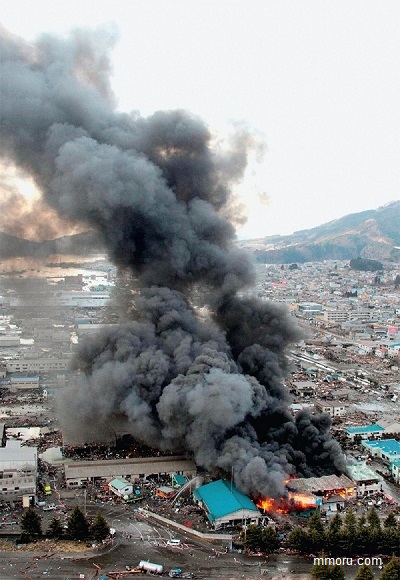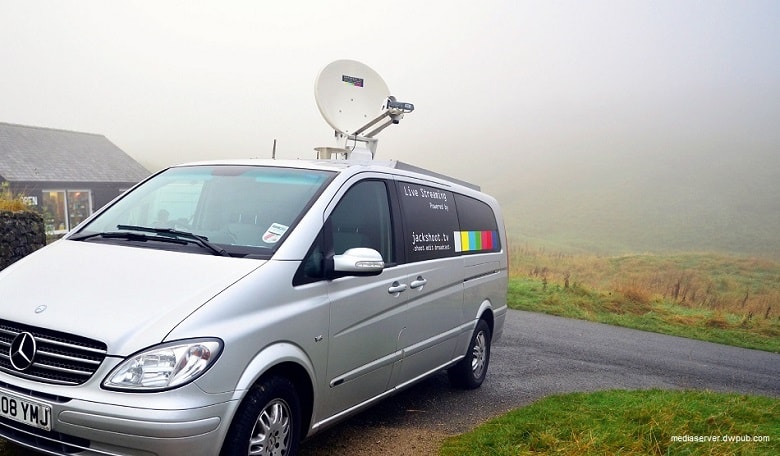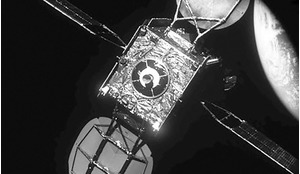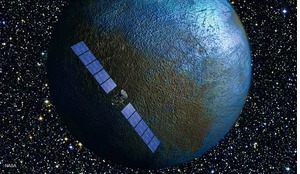As a satellite professional, I’m often asked to participate in panel discussions at various industry functions. Most of them have titles like, “Is satellite still relevant to newsgathering?” In an environment where cheap, fast internet connections are taken for granted and where consumer equipment is ubiquitous and inexpensive, it’s a question worth asking.
We find ourselves in a technological accelerando, and Information Technology – and that subset of IT we call the Satellite Industry – will continue to revolutionize the way we interact with each other. Mass media, and newsgathering in particular, has been turned on its head by these changes.
Satellite has remained a relevant communications platform largely due to its inherent advantages: No technology has satellite’s global reach and no transmission technology in existence is as reliable. Indeed, satellite seems built to embrace some of the emerging challenges facing IT, and as an industry, satellite is doubling down on its ability to do so.
So what is to be said about satellite and its longstanding relationship with news gathering? In many ways, news propelled the evolution of satellite technology. Now these same news organisations are struggling to remain relevant in the era of always-on connectivity, New Media and the complete democratisation of information.
We can argue about quality journalism and the editorial direction of newsrooms all we want, but the trend is obvious: News organisations are using less satellite capacity.
Is satellite too expensive?
A common refrain in television newsrooms is that satellite is too expensive. This is arguable. Nevertheless, news organizations need to do more with less, and the trend is toward terrestrial, public connection technologies like public Wi-Fi and cellular networks. Reliability and quality aside, the belief is that these systems can replace satellite infrastructure for most newsgathering needs.
There is no doubt that new technologies such as cellular bonding, which allows a user to combine multiple 3G and 4G wireless cards into a single unit and ramp up their bandwidth for video contribution, have had a real impact on conventional satellite news gathering.
Yet as I look from the other side of the fence as a provider, I can see that newsgathering is not leaving satellite behind. Exactly the opposite is true. Satellite and information technology are moving on, and the entrenched way of gathering news is becoming no more relevant than the teletype or telex or fax machine.
Where does this leave newsgathering? Is the satellite news van an endangered species? Will all journalists become tied to terrestrial solutions and absorb their inherent limitations in quality and reliability? Is news just an extension of the social media universe now?
To answer these questions we need to understand what satellite and newsgathering were – what they fought against becoming, and what, finally, they have embraced.
When satellite was a game-changer
News organisations were using satellites to move video as far back as the moon landings. This became more routine in the 70s, and the words “via satellite” superimposed over a major news story added gravitas and a sense of urgency and importance to major events. To an industry used to dropping a roll of film in a mailbox and waiting a week or more for it to arrive at the studio, satellite was a game-changer.
During the 80s, satellite expanded and became more accessible. Smaller electronics, the advent of additional frequency ranges, and an explosion in audience expectations drove news organisations to invest in their own satellite ground infrastructure. Mobile news vans with uplink dishes became necessities for most medium-to-large news organizations. Remote deployment “fly-away” systems were sent overseas to cover events as they happened. “Live via Satellite” did not necessarily mean a live image was originating on the other side of the world, either. It could just as easily be coming from up the street.
You can’t throw more bandwidth at a satellite internet latency problem and solve it
The first Gulf War exemplified what aggressive news organizations could do with satellite technology. Vietnam may have been the first “TV War”, but Gulf War One was the first “Live” TV War, and it set the bar for every major news event that followed.
Video and transmission delays
The internet revolution jump-started the expansion of terrestrial communications networks – fibre optics, cellular technologies, and Wi-Fi all popularized the idea that all information could be readily available to anyone with an internet connection. As these technologies advanced it became obvious that satellite was not always the best way to move video, especially in areas with advanced infrastructure. And here we come to the main Achilles heel of satellite technology.
 Japan’s tsunami made the media’s job tougher
Japan’s tsunami made the media’s job tougher
One would think that satellites would be extremely well positioned to provide internet over wide areas of the planet. From the standpoint of reach, this is true. Beyond this, though, we run into numerous problems.
The distance a satellite orbits the earth – about 36,000 kilometres – introduces a very evident transmission delay. We have all seen it during those famous “live via satellite” interviews. This type of delay plays havoc with Internet Protocol, which expects delays of a few milliseconds, not hundreds of milliseconds. Data transport slows down.
When a catastrophe happens, satellite is your only option
You can’t just throw more bandwidth at a satellite internet latency problem and solve it. Protocols like HTTP and FTP require acknowledgement data and a two-way link to operate. When every group of packets is waiting a few hundred milliseconds to arrive, things slow down.
We also have a throughput problem. Historically, there is just not a lot of total bandwidth on a conventional geostationary communications satellite. There is more internet bandwidth serving many small neighbourhoods than exists on a typical satellite. When you consider that satellite is expected to blanket millions of square miles of planet with data service, the limitations start to add up.
’Live via satellite’ is a familiar concept to viewers
This is not to say there weren’t and aren’t decent satellite IP options out there. Numerous companies provide satellite internet to remote areas. Inmarsat built its business around remote, mobile satellite internet. Companies like Eutelsat, SES, and ViaSat all have consumer satellite IP products, and these platforms are successful alternatives in areas where terrestrial connectivity is a challenge or massive throughput is not necessary.
Meanwhile news organisations addressed some of the limitations by figuring out how to reliably move highly compressed live video over satellite IP using lossy protocols like UDP. They traded quality for speed, but due to an overall shortage in bandwidth for these applications, it was very expensive. And the lower quality inherent in such links was being noticed. News organizations waited for a time when IP video was indistinguishable from high quality SD or HD video.
And these advances came. Fast 3G/4G cellular and terrestrial internet made it realistic for news organizations to move high-quality video over public networks. The use of satellite uplinks began shrinking. Satellite providers began to realize that in order to compete in the world of IP, entirely new satellite technologies needed to be developed while existing ones were optimized.
The disaster niche
Today, although news is still a large piece of the satellite video market, it tends to be driven by special events and breaking news. When a catastrophe happens, satellite is your only option.
The Japanese earthquake and tsunami devastated one of the most technologically advanced nations on the planet. There was no way to get around that without involving satellite technology.
The Philippines Typhoon of last year, the on-going conflicts in Iraq and Afghanistan and dozens of other remote hotspots still require news organizations to deploy satellite equipment. At SES, we continue to have a robust Occasional Use business catering to these needs. So do most major operators.
Mesh technologies and other innovations
Meanwhile, satellite continues to play to its strengths and evolve to address its weaknesses. Satellite remains a huge player in direct-to-home television programing, particularly in Europe, where few cable standards exist, and in developing countries in South America, Africa, India and Asia. When it comes to large-scale sporting events such as this year’s World Cup, the Olympics, and other regional sports league coverage, satellite continues to hold the high ground.
Satellite is the only way that humans have figured out how to make money in space
 There is no need for the media to be too nostalgic for old technology
There is no need for the media to be too nostalgic for old technology
Satellite has also embraced new verticals, technologies such as High Throughput Satellite and the new O3b system are making internet-over-satellite much more relevant. We are seeing the emergence of mesh technologies, combinations of satellite and aeronautical platforms designed to bridge the gaps in terrestrial infrastructure – particularly in the aero and maritime markets.
The future is bright for satellite as a mobility service, and more markets open up all the time. My friend and colleague, Robert Bell, once mentioned that satellite is the only way that humans have figured out how to make money in space. This is true now more than ever. Satellites are being designed and targeted at these solutions before the rockets leave the ground.
At the same time, it is important to note that news has become “platform-agnostic.” Journalists today, like most people in our social media revolution, think of data as “always there.”
If the choice between getting a major story and not getting it is deploying satellite resources, then those resources will be deployed. But for the daily news grind, in an environment where people are just as likely to navigate to Yahoo! News as they are to tune into CNN, most video acquisition will be “best effort” using public networks, and news organizations will continue to move away from the “roll the truck” mentality that permeated work flows for the last three decades.
Forget nostalgia
There is no need to be too nostalgic about this. Technology moves forward and behaviours change. The decrease in satellite newsgathering is not bad news for anyone – it has forced satellite to change and continues to push media and news companies to innovate.
As I stated earlier, the advantages satellite brings to the table cannot be equalled by any other transmission technology. No technology reaches more people, and no technology is as reliable. When a single spacecraft can provide information to an entire hemisphere of people, well, there is nothing out there in IT that provides more bang for the buck or more potential to affect positive change.
In the meantime, news organizations have a bigger issue: Staying relevant in a world where they’re competing not with each other, but with social media, with ubiquitous cameras, with Google and Wikipedia and YouTube and hundreds of other outlets. Perhaps the question is not “Is satellite relevant to newsgathering?” Maybe the real question is, “Is conventional newsgathering still relevant at all?”














